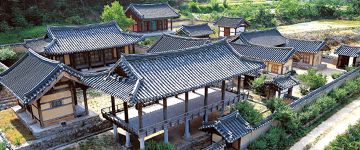안동 화천서원
| 안동 화천서원 Hwacheonseowon Confucian Academy, Andong |
|
 "화천서원", 안동하회마을. |
|
| 대표명칭 | 안동 화천서원 |
|---|---|
| 영문명칭 | Hwacheonseowon Confucian Academy, Andong |
| 한자 | 安東 花川書院 |
| 주소 | 경상북도 안동시 광덕솔밭길 72 (풍천면) |
| 지정번호 | 시도기념물 제163호 |
| 지정일 | 2009년 11월 23일 |
| 분류 | 유적건조물/교육문화/교육기관/서원 |
| 시대 | 조선시대 |
| 수량/면적 | 1곽(8동) |
| 웹사이트 | 안동 화천서원, 국가문화유산포털, 문화재청. |
|
|
|
해설문
기존 국문
이 서원은 겸암 謙庵 류운용 柳雲龍1539~1601 선생의 학덕을 흠모하던 지역 유림들이 선생의 위패를 모시고 인재를 양성하기 위하여 정조 10년1786에 건립되었다.
그후 동리東籬 김윤안金允安과 졸재拙齋 류원지柳元之를 추가로 배향하고 100여년 동안 봄가을로 향사를 지냈다. 그러나 1871년 흥성대원군의 서원 철폐령에 의해 강당과 주사만 남기고 훼철됐다. 서원의 훼철을 아쉬워하던 후손들이 1966년부터 기금을 모아 유림들의 공론으로 1996년에 복설하여 지금의 모습을 갖추었다. 화천서원의 문루인 지산루地山樓에 올라 밖을 내다보면 넓게 펼쳐진 모래사장과 굽이쳐 흐르는 낙동강이 한눈에 들어온다.
수정 국문
서원은 조선시대에 세워진 사립 교육기관으로, 선현 제향과 교육의 기능을 수행하였다.
화천서원은 조선 중기의 문신이자 학자인 류운룡(柳雲龍, 1539~1601)을 모신 서원이다. 류운룡의 학덕을 흠모하던 지역 유림들이 1786년에 건립하였다.
하회에서 태어난 류운룡은 대유학자인 이황의 제자로 학문에 힘썼고 효심이 깊었다. 관직에 있을 때 어진 행정으로 이름이 높았으며, 풍기군수와 원주목사 등을 역임하였다. 사후에 이조판서로 추증되었다.
1803년 류운룡과 류성룡의 제자 김윤안(金允安, 1562~1620), 류성룡의 손자이면서 류운룡의 학문을 계승한 류원지(柳元之, 1598~1674)를 추가로 배향하였다. 그러나 1871년 흥선대원군의 서원 철폐령에 의해 강당과 관리동만 남기고 훼철되었다. 이후 후손과 유림들이 1996년에 다른 건물들을 복원하여 현재에 이른다.
서원은 정문, 강당, 동재와 서재, 내삼문, 사당으로 구성되어 있다. 강당인 숭교당은 마루를 중심으로 양쪽에 방을 두었다.
화천서원의 문루인 지산루에 올라 밖을 내다보면 넓게 펼쳐진 모래사장과 굽이쳐 흐르는 낙동강이 한눈에 들어온다.
영문
Hwacheonseowon Confucian Academy, Andong
Confucian academies, called seowon in Korean, are private education institutions of the Joseon period (1392-1910) which usually combined the functions of a Confucian shrine and a lecture hall.
Hwacheonseowon is dedicated to Ryu Un-ryong (1539-1601), a civil official and Confucian scholar in the middle period of Joseon dynasty (1392-1910). It was built by local Confucianists to honor Ryu for his academic achievement and virtuous deeds throughout his life.
Born in Hahoe Village, Ryu Un-ryong was a disciple of Yi Hwang, one of the most eminent Confucian scholars of the Joseon Dynasty. Ryu was renowned for his wise administrations while in service. He served as magistrate of Punggi and governor of Wonju. After his death, he was posthumously promoted to minister of Personnel.
In 1803, the spirit tablets of Kim Yun-can (1392-1662), a disciple of Ryu Un-ryong and his brother Ryu Seong-ryong, and Ryu Won-ji(1589-1674), a grandson of Ryu Seong-ryong and successor to the school of Ryu Un-ryong were also enshrined in Hwacheonseowon. However, it was eventually demolished in 1871, following an 1864 nationwide decree to shut down shrines and Confucian academies and bury any spirit tablets that were enshrined there. In 1996, Ryu’s descendants and local Confucianists reconstructed the local academy.
This local Confucian academy is composed of the gateway, lecture hall, dormitories, inner gate, and shrine. The lecture hall named Sunggyodang has a wooden floored hall flanked by a room on either side.
From the gate quarters of Hwacheonseowon called Jisanru, a panoramic view of beach and winding Nakdonggang river is presented.